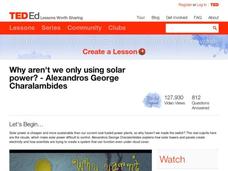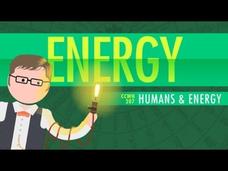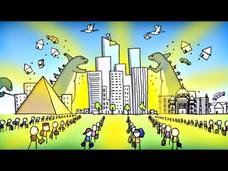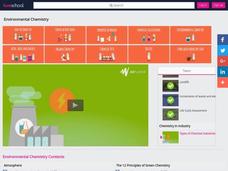TED-Ed
Why Aren't We Only Using Solar Power?
Drive the clouds away from your day with this video. It thoroughly details how photovoltaics work and how clouds prevent us from relying solely on solar as an energy source. Unique knitted-object animation (bunnies, clouds, and all...
Crash Course
Humans and Energy: Crash Course World History 207
Is flipping a switch and lighting up a room normal or miraculous? It depends where—and when—you live. Crash Course World History covers historical uses of energy, current uses of energy, and the possible future uses of energy with an...
TED-Ed
How Quantum Mechanics Explains Global Warming
What do quantum mechanics and global warming have to do with each other? More than you might think. Surprisingly, this video explains how it's not the energy emitted from the sun that causes the problem, but how the infrared radiation...
Curated OER
The Story of Petroleum
An array of video clips, photographs, and drawings keep visual learners engaged, and an agreeable narration voice draws in auditory learners. It begins by explaining the formation of fossil fuels and progresses into how oil is located,...
TED-Ed
Biodiesel: The Afterlife of Oil
Use this slick video to introduce your environmental scientists to the wonders of biodiesel. They will learn about problems caused by our waste oil, how it can be recycled, and other benefits of using biofuels. Use the video, assessment...
Fuse School
Environmental Impacts of Detergents
Dangerous detergents? Who knew? Pupils learn of the darker side of laundry day as they complete the series of seven videos on water and the environment. The video shows common detergent ingredients, how these ingredients can harm the...
MinuteEarth
How to Build a Better City
Think you're helping the environment by living in the suburbs rather than the city? Think again! Young scientists examine the effects of urban sprawl in a video that compares the environmental advantages of closely packed city life to...
Curated OER
Crude Oil
Watch the distillation process as a female narrator explains what is happening. Ideally you would demonstrate this process or have advanced classes work in lab groups to perform it themselves. If time is short or materials not available,...
Crash Course
Environmental Econ
How does the economy affect the environment—and vice versa? A video from Crash Course Economics discusses the ways supply and demand for products made with non-renewable resources can result in the Tragedy of the Commons, or even in the...
Howard Hughes Medical Institute
How We Get Our Skin Color
Is our skin color determined only by genetics? Explore skin science through a video and related interactive. Young biologists discover the cells of the epidermis, how melanin is made, and the factors that influence the outward appearance...
TED-Ed
How to Create Cleaner Coal
It's easy to take for granted the the importance of electricity in modern society, and even easier to overlook the environmental cost that is paid for all that energy. Watch as this video explores the detrimental impact...
Fuse School
Green Chemistry - Principle 8
Energy conservation is a global effort, but how can chemists aid the cause? The narrator in the eighth installment of a 12-part Green Chemistry series describes the importance of reducing reactant waste while performing reactions with...
TED-Ed
What Is the Tragedy of the Commons?
What's good for all of us is good for each of us. The Tragedy of the Commons refers to a situation in which one person's decision to act in his or her own best interest negatively affects the rest of the population—and ultimately, him or...
Crash Course Kids
Living Things Change
What happens to organisms when the environment around them changes? This is the focus of a video that describes how living things must adapt to their ever-changing environment.
Crash Course
The Anthropocene and the Near Future: Crash Course Big History #9
The Anthropocene covers the last century in an unofficial geological era. An informative video considers both the pros and cons of progress. It discusses the environmental impact, changes in lifestyle, political changes, wars, and...
Fuse School
Future Extraction Methods
How do plants and bacteria help us gain access to our Earth's precious copper reserves? Scholars gain knowledge of the processes of bioleaching and phytomining in the seventh and final installment in a series discussing rocks and their...
Fuse School
Reducing Acid Rain or its Effect
How do we stop acid rain from forming or repair the damages it causes? The seventh and final video in the series presents learners with common methods of reducing the harmful effects of acid rain. Topics such as the scrubbers used...
Veritasium
Why Are 96,000,000 Black Balls on This Reservoir?
A Los Angeles reservoir is the largest ball pit on Earth. Learn the problem and solution of the water treatment plant in LA in a Veritasium video lesson. An unexpected chemical reaction created an issue in the treatment of water, and the...
Curated OER
Mining the New American West
The Mining Act of 1872 allows mining companies to purchase land from the U.S. Government at 1872 prices - about $5.00 an acre! This video features the town of Crested Butte, Colorado, and a mountain just outside of town that was...
California Academy of Science
Buses and Biofuels: Sustainable Transportation
One-third of all carbon emissions comes from transportation in the United States. The third lesson in a 13-part series on Exploring Energy offers ideas on how to reduce emissions from cars, airplanes, large trucks, and more.
Fuse School
Types of Chemical Industries
Four percent of the world's CO2 emissions come from the chemical industry. The video discusses the environmental impact of industry. From using non-renewable resources, requiring high levels of energy, to polluting the ground, water, and...
California Academy of Science
The Chemistry of Clothes
Synthetic materials increase in popularity every year. Exploring Energy takes on the chemistry behind synthetic materials, including polyester. The resource opens with a video explaining the difference between natural and synthetic...
Howard Hughes Medical Institute
Coral Bleaching
What is coral bleaching? Tackle a trendy topic with a narrated animation. Through a combination of video and illustration, the narrator introduces viewers to a coral reef, then goes inside a coral polyp to show its symbiotic relationship...
Fuse School
Carbon Footprints
Can one person really make a difference in the battle to reduce global warming? Absolutely! Viewers explore ideas for making less of an impact on our planet in the sixth installment of an eight-video series. Topics range from modes...























